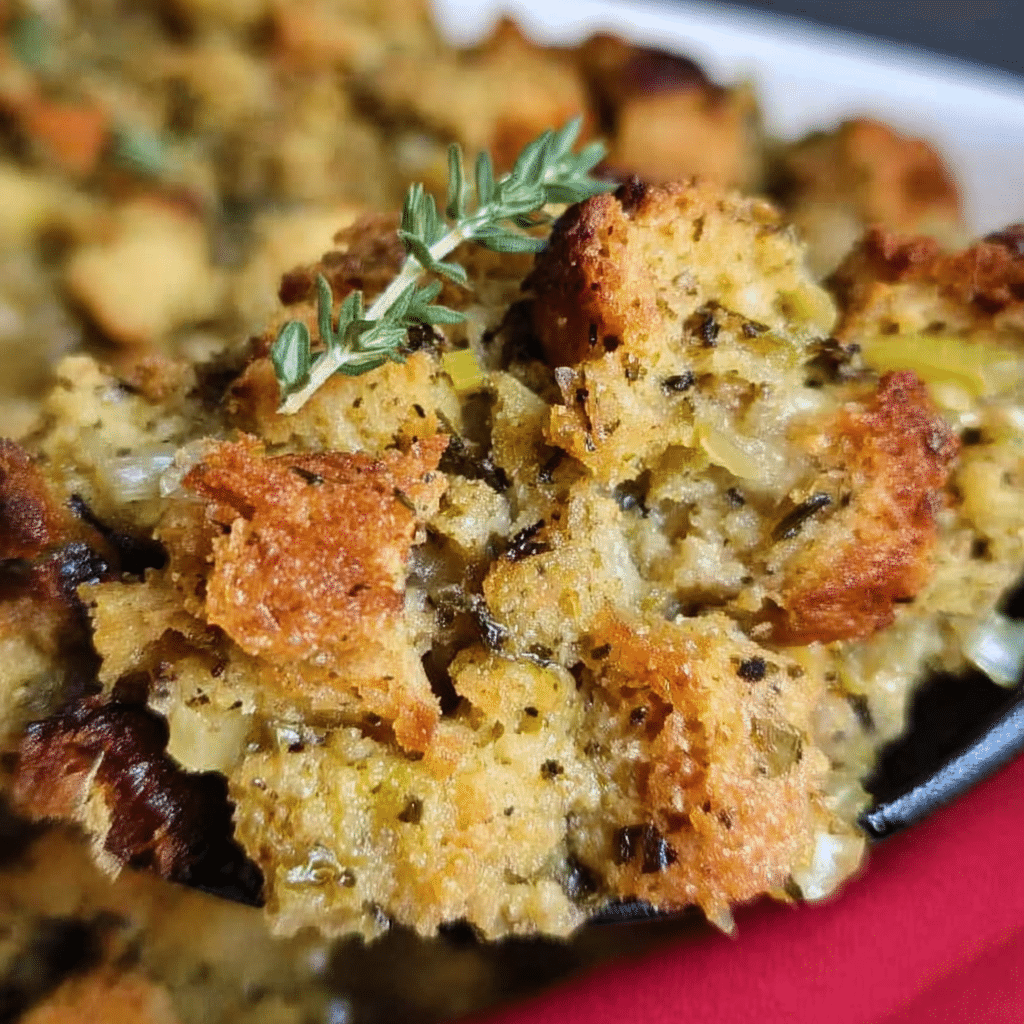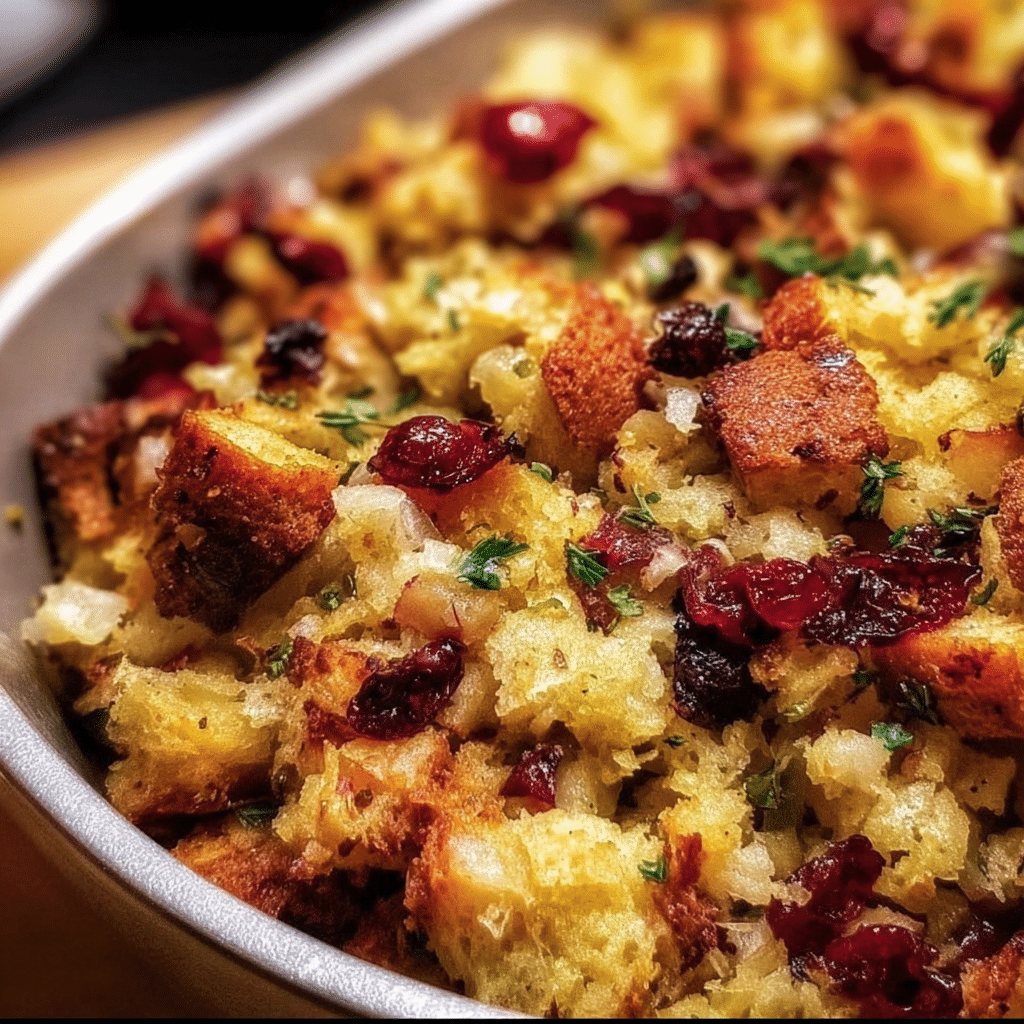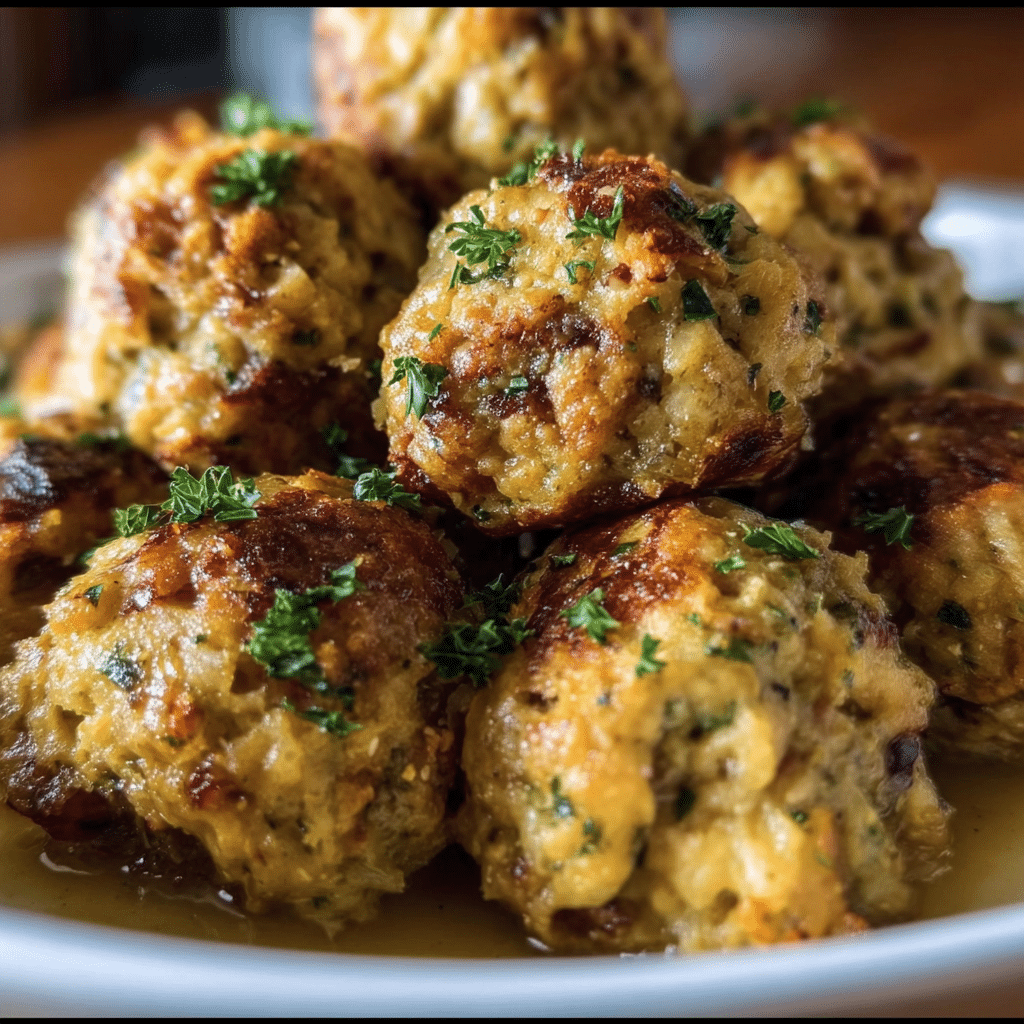Best-ever sourdough stuffing is not just a dish; it’s a celebration of flavors, an embrace of tradition, and a nod to the comfort food that brings families together. I remember the first time I made this stuffing—it was a crisp November afternoon, and the smell of freshly baked sourdough bread filled my kitchen. My family had gathered for our annual Thanksgiving feast, and I was determined to create something special. As I mixed the ingredients, the warmth of nostalgia washed over me. This wasn’t just a recipe; it was a way to honor the memories of my grandmother, who would spend hours in the kitchen crafting her own version of stuffing. I knew then that I was on the path to discovering the best-ever sourdough stuffing.
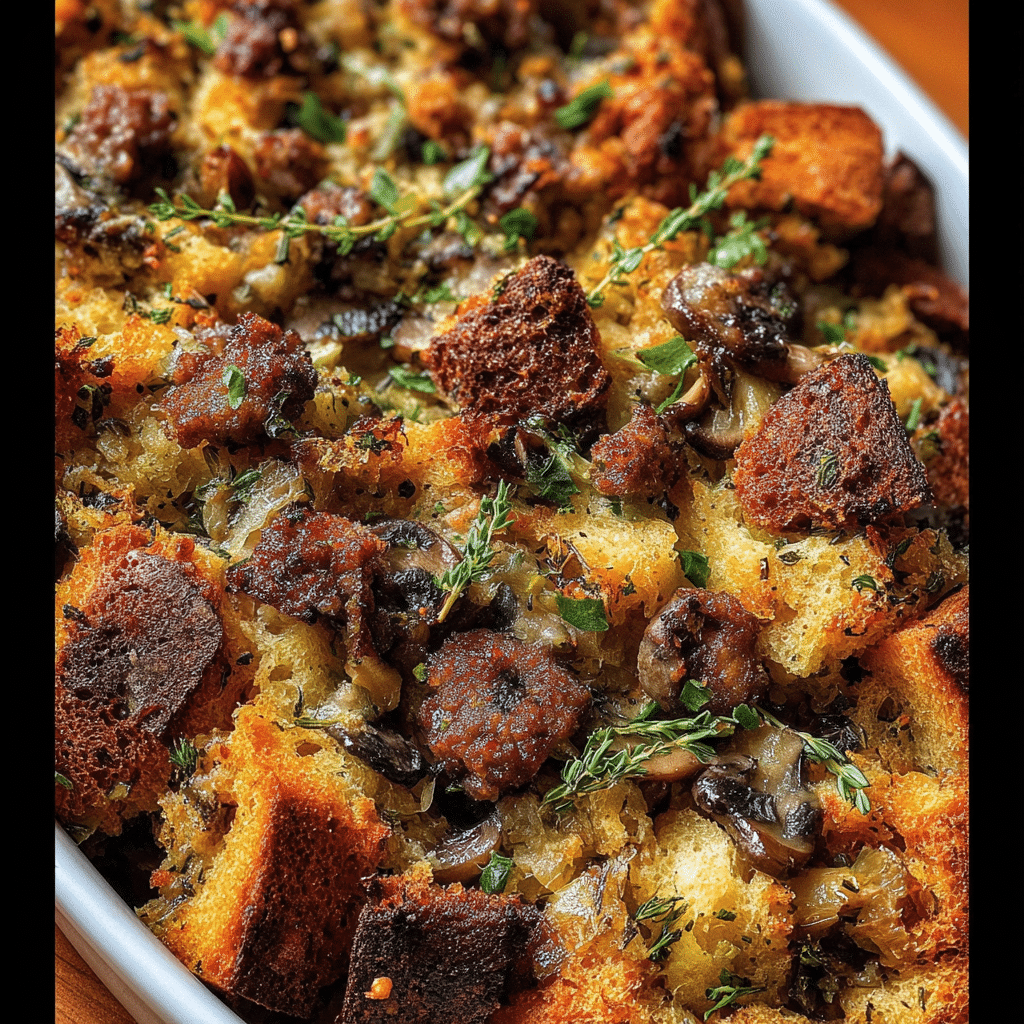
The Story Behind This Recipe
As I dove deeper into the world of sourdough stuffing, I realized that this dish has roots that stretch far beyond my own family kitchen. Stuffing, or dressing as some call it, has been a staple of holiday meals for centuries, with variations found in almost every culture. The idea of filling a bread mixture with herbs, spices, and other flavorful components can be traced back to ancient times when people would use stale bread to soak up juices and enhance the flavors of meats. The addition of sourdough bread brings a tangy twist that elevates this dish to a whole new level.
What makes my recipe stand out is the addition of savory sausage and earthy mushrooms, which create a hearty filling that pairs beautifully with roasted turkey or chicken. I love how the sourdough absorbs the flavors of the broth and the spices, resulting in a stuffing that is both flavorful and satisfying. As I cooked, I couldn’t help but think of my grandmother’s teachings: “A great stuffing needs time, patience, and a whole lot of love.” This recipe captures all of that and more.
For busy families looking for quick dinner solutions, best-ever sourdough stuffing is the perfect dish. It can be prepared in advance, allowing you to focus on other elements of your meal. You can even use leftover sourdough bread, making it an economical choice that reduces waste. It’s a versatile dish that can be served alongside a holiday roast or as a comforting side on a weeknight; it never fails to impress.
Seasonally, this stuffing shines particularly during the fall and winter months, when hearty flavors and cozy meals take center stage. However, I believe it can be enjoyed year-round, especially when you have a craving for that warm, homey feeling it brings. The emotional connection to this dish is profound—it evokes memories of family gatherings, laughter around the table, and the simple joy of sharing a meal with loved ones.
In this guide, you will learn how to create the best-ever sourdough stuffing that will not only become a staple in your own kitchen but will also impress your guests. From selecting the best ingredients to mastering the cooking techniques, I’ll share everything you need to know to make this stuffing truly unforgettable. Prepare to embark on a culinary journey that embraces tradition while adding your own unique twist!
The Rich History and Cultural Significance of best-ever sourdough stuffing
The best-ever sourdough stuffing has a rich history that is intertwined with various cultural practices around the world. The concept of stuffing dates back to ancient civilizations, where it was common to fill birds or vegetables with a mixture of bread and local herbs. The earliest records of stuffing can be traced to the Roman Empire, where recipes were written down in cookbooks, showcasing a variety of stuffing techniques that have influenced modern-day cooking.
Origins and History
Sourdough, specifically, has a fascinating origin story that enhances the narrative of this stuffing. Sourdough bread has been made for thousands of years, originating in ancient Egypt. Its unique fermentation process not only gives it a distinctive flavor but also makes it more nutritious and easier to digest. When combined with the stuffing concept, sourdough adds a depth of flavor that elevates any dish it graces, particularly during holiday meals.
As the centuries passed, regional variations of stuffing emerged, shaped by local ingredients and culinary traditions. In New England, traditional stuffing often includes cornbread, while Southern versions may feature spices and sausage. The versatility of stuffing has led to countless adaptations, but the addition of sourdough brings a unique twist that is beloved by many.
Cultural Significance
Culturally, stuffing has been a significant part of holiday meals, particularly in the United States during Thanksgiving. It symbolizes abundance and gratitude, often referred to as “dressing” in the Southern states. The preparation and sharing of stuffing have become a bonding experience for families, where recipes are passed down through generations, each with its own flair. From family gatherings to festive celebrations, best-ever sourdough stuffing has become a centerpiece that embodies community and connection.
Notably, many renowned chefs have elevated this classic dish in their restaurants, adding gourmet twists that showcase the versatility of stuffing. Chefs like Thomas Keller and Ina Garten have incorporated their own interpretations, but the heart of the dish remains the same: a mix of bread, herbs, and love. Their recipes have inspired countless home cooks to experiment and create their own versions, proving that stuffing can be both traditional and innovative.
Nutritional Benefits
From a nutritional standpoint, sourdough bread has several health benefits. The fermentation process helps break down gluten, making it easier for many people to digest. Additionally, sourdough is rich in vitamins and minerals due to the fermentation of whole grains. When combined with protein-rich sausage and fiber-rich mushrooms, best-ever sourdough stuffing becomes a satisfying and nourishing option for any meal. It’s a dish that not only delights the palate but also supports overall well-being.
In conclusion, the best-ever sourdough stuffing is steeped in history and cultural significance, grounded in the traditions of home cooking but ripe for modern interpretation. It serves as a reminder of the joy of cooking for loved ones and the importance of sharing meals that connect us to our roots. With each bite, you’re not just tasting a dish; you’re experiencing a legacy that continues to evolve while maintaining its cherished essence.
Essential Ingredients for Perfect best-ever sourdough stuffing
When it comes to creating the best-ever sourdough stuffing, the magic truly lies in the ingredients you choose. Each component contributes to the overall flavor and texture of the dish, making it not just a side but a star on your holiday table. Let’s dive into the essential ingredients that will elevate your stuffing from ordinary to extraordinary.
Essential Ingredients
- 24 ounces sourdough bread, sliced 1-inch thick and torn into ½-inch pieces
- 3 tablespoons unsalted butter, melted
- 3 cloves garlic, finely chopped or grated
- 3 tablespoons finely chopped fresh herbs (e.g. sage, thyme)
- ¾ teaspoon kosher salt
- 3 tablespoons unsalted butter
- 1 large yellow onion, diced
- 3 ribs celery, finely diced
- 3 cloves garlic, finely chopped or grated
- 1 and ½ pounds sage pork sausage, casings removed if needed
- 12 ounces cremini (baby bella) mushrooms, thinly sliced
- 8 ounces sharp white cheddar, freshly grated (about 2 cups packed)
- 3 tablespoons finely chopped fresh sage leaves
- 3 tablespoons fresh thyme leaves
- 1 tablespoon finely chopped fresh rosemary
- 3 large eggs, whisked
- 2–3 cups chicken stock or broth, divided
- Kosher salt and ground black pepper, to season

Best-Ever Sourdough Stuffing with Sausage & Mushrooms
Ingredients
for the homemade bread cubes:
- 24 ounces sourdough bread, sliced 1-inch thick and torn into ½-inch pieces
- 3 tablespoons unsalted butter, melted
- 3 cloves garlic, finely chopped or grated
- 3 tablespoons finely chopped fresh herbs (e.g. sage, thyme)
- ¾ teaspoon kosher salt
for the sausage stuffing:
- 3 tablespoons unsalted butter
- 1 large yellow onion, diced
- 3 ribs celery, finely diced
- 3 cloves garlic, finely chopped or grated
- 1 and ½ pounds sage pork sausage, casings removed if needed
- 12 ounces cremini (baby bella) mushrooms, thinly sliced
- 8 ounces sharp white cheddar, freshly grated (about 2 cups packed)
- 3 tablespoons finely chopped fresh sage leaves
- 3 tablespoons fresh thyme leaves
- 1 tablespoon finely chopped fresh rosemary
- 3 large eggs, whisked
- 2–3 cups chicken stock or broth, divided
- kosher salt and ground black pepper, to season
Instructions
- Preheat the oven to 425 degrees F. Line 2 large baking sheets with parchment paper or foil for easy cleanup. Lightly grease a 9×13-inch baking dish. Set aside.Sourdough bread cubes, butter, herbs, eggs, garlic, sage pork sausage, mushrooms, onions, celery, chicken stock & cheese arranged on a light blue surface.
- Toast the bread: Divide the torn sourdough bread pieces across the 2 baking sheets. In a small bowl, whisk together the butter, garlic, herbs and kosher salt. Drizzle the garlic herb butter over the bread and use your hands to toss to coat. Arrange the bread in an even layer on the baking sheets. Bake 10-12 minutes, until the bread dries out slightly. Do not let the bread get too, too browned at this point – a nice, light golden brown is perfect. Remove from the oven and set aside to cool. Once cooled, you may transfer to an airtight container and store at room temperature for up to 5 days.Toasted sourdough bread pieces are arranged on a baking sheet lined with parchment paper. The baking sheet rests atop a light textured surface with a gray and white striped linen napkin and sprigs of fresh herbs surrounding the baking sheet.
- Brown the sausage: Meanwhile, as the bread toasts, brown the sausage. Add the butter to a large pan over medium heat. Once melted, add the onion and celery. Season with ½ teaspoon kosher salt and cook, stirring occasionally, for 5-7 minutes, until softened. Add in the garlic and cook 1-2 minutes more, until fragrant. Add in the sausage. Continue to cook, using a wooden spoon to break the sausage into bite-sized pieces as it cooks, until cooked through, 5-6 minutes. Remove from the heat.Browned sausage, onion, and celery mixture fills a large red Staub cast iron skillet. The skillet sits atop a light textured surface with a gray and white striped linen napkin resting alongside and a few fresh sage leaves and sprigs of thyme surround the skillet as well. A wooden spoon used to stir the sausage mixture while browning rests inside of the skillet.
- Assemble the sausage stuffing: Decrease the oven temperature to 350 degrees F. Place the toasted sourdough and the browned sausage mixture in a large mixing bowl. Add in the sliced mushrooms, grated cheddar, chopped sage, thyme and rosemary, and season with ½ teaspoon kosher salt. Pour the eggs over top. Toss well to combine. Pour in 1 cup of stock and toss well to combine. If the stuffing seems too dry, add in 1 more cup of stock and toss well to combine. Repeat once more if needed.Browned sausage, celery, and onion, toasted sourdough breadcrumbs, sliced cremini mushrooms, chopped sage, thyme, and rosemary, and grated sharp white cheddar cheese fill a glass mixing bowl and have been mixed together with a wooden mixing spoon along with melted butter and chicken stock. A liquid measuring cup filled with remaining chicken stock, a gray and white striped linen napkin, and fresh herbs surround the mixing bowl.
- Bake the sausage stuffing: Transfer the stuffing mixture to the prepared baking dish. Bake at 350 degrees, uncovered, for 45-55 minutes, until the top of the stuffing is crispy and browned.An assembled stuffing side dish fills a white baking dish. The baking dish rests atop a light textured surface surrounded by a gray and white striped linen napkin and fresh herbs.
- Serve immediately. Enjoy!
Let’s explore each ingredient to understand its role in crafting the best-ever sourdough stuffing.
Sourdough Bread: The backbone of any stuffing, sourdough bread provides a unique tang and chewy texture that elevates the dish. Its crusty exterior and soft inside soak up all the flavorful juices without turning mushy. Aim for bread that’s at least a day old; slightly stale bread holds up better and allows for a more robust flavor.
Unsalted Butter: Butter adds richness and depth to the stuffing. Using unsalted butter allows you to control the salt content, ensuring your dish isn’t overly salty. The melted butter is also crucial for sautéing the vegetables, enhancing their flavors beautifully.
Garlic: Fresh garlic provides a pungent and aromatic flavor that infuses the stuffing with warmth. It’s best to use fresh garlic rather than garlic powder for a more vibrant taste.
Fresh Herbs: A medley of fresh herbs, particularly sage and thyme, brings an earthy and fragrant note to the stuffing. These herbs are traditionally associated with holiday cooking, evoking a sense of nostalgia and warmth. When selecting herbs, opt for vibrant, fragrant leaves and chop them finely to release their oils.
Kosher Salt: Essential for seasoning, kosher salt enhances the flavors of your ingredients. It’s less salty than table salt, making it easier to sprinkle and control the seasoning level.
Onion and Celery: Known as the aromatic base of many dishes, diced onion and celery add sweetness and depth to your stuffing. They should be sautéed until soft and translucent, creating a flavorful foundation.
Sage Pork Sausage: The addition of sage pork sausage introduces a hearty, savory element that complements the sourdough beautifully. Look for high-quality sausage with visible herbs and spices for the best flavor.
Cremini Mushrooms: These mushrooms add a rich, umami flavor and a lovely texture contrast to the stuffing. When sliced thinly, they absorb flavor from the other ingredients while providing their distinct earthiness.
Sharp White Cheddar: A surprising yet delightful addition, sharp white cheddar brings creaminess and a tangy bite that balances the richness of the sausage and butter. Grating your cheese fresh ensures maximum flavor.
Eggs: Whisked eggs serve as a binding agent, helping to hold everything together while providing a rich flavor. They also contribute to a slightly custardy texture in the final dish.
Chicken Stock or Broth: Stock is the lifeblood of your stuffing, adding moisture and flavor. Homemade stock is ideal, but store-bought works fine; just ensure it’s low-sodium so you can control the saltiness of the dish.
Seasoning: Ground black pepper and additional salt to taste are essential for rounding out the dish. Remember to taste as you go to achieve the perfect balance.
Shopping Tips
When sourcing your ingredients for the best-ever sourdough stuffing, consider visiting local farmers’ markets for fresh produce and herbs. Organic ingredients may be pricier, but they often provide better flavors and fewer chemicals. Look for artisanal sourdough bread from a local bakery; it makes a world of difference in taste and texture. If you’re buying packaged items, check for high-quality brands that offer the freshest ingredients.
Substitutions and Alternatives
If you have dietary restrictions, don’t worry! This stuffing is highly adaptable. For a vegetarian version, substitute the sausage with plant-based sausage or additional mushrooms for more umami flavor. Replace chicken stock with vegetable broth for a vegan option. For gluten-free needs, use gluten-free bread, ensuring it has a similar texture to sourdough. Each of these substitutions maintains the spirit of the dish while accommodating different dietary requirements.
Lastly, consider storage tips: Keep your bread in a paper bag to prevent it from becoming too stale, while fresh herbs should be wrapped in a damp paper towel and stored in the refrigerator for maximum freshness. By taking care of your ingredients, you’ll ensure that your best-ever sourdough stuffing is as delicious as it can be!
Detailed Step-by-Step best-ever sourdough stuffing Cooking Instructions
Creating the best-ever sourdough stuffing is a delightful journey that involves methodical preparation and a dash of love. Following these detailed step-by-step instructions will guide you through the process, ensuring that you achieve a stuffing that is flavorful, moist, and perfectly textured. Let’s get started!
Preparation Steps
- Preheat your oven: Start by preheating your oven to 350°F (175°C). This temperature is ideal for baking your stuffing to a golden perfection.
- Prepare the sourdough bread: Tear the sourdough bread into ½-inch pieces and spread them out on a baking sheet. Allow the bread to dry out for about 30 minutes while the oven is preheating. Dried bread absorbs the flavors beautifully without becoming soggy.
- Chop your vegetables: Dice the onion and celery finely. The smaller the pieces, the more evenly they’ll cook and blend into the stuffing. Finely chop or grate the garlic and herbs as well.
- Measure your ingredients: Gather and measure all the ingredients before starting. This mise en place method will streamline your cooking process and help you avoid missing any components.
Cooking Process
- Sauté the aromatics: In a large skillet over medium heat, melt 3 tablespoons of unsalted butter. Add the diced onion and celery, cooking until they are soft and translucent, about 5-7 minutes. This step is crucial as it develops a deep flavor base for your stuffing.
- Add the garlic and herbs: Stir in the chopped garlic and fresh herbs (sage and thyme) and cook for an additional 1-2 minutes until fragrant. Be careful not to burn the garlic, as it can turn bitter.
- Cook the sausage: Push the vegetable mixture to one side of the skillet and add the sausage to the other side. Break the sausage into small pieces with a wooden spoon as it browns. Cook until the sausage is no longer pink, about 5-7 minutes. Combine it with the vegetables once cooked through.
- Add the mushrooms: Once the sausage is cooked, add the sliced cremini mushrooms to the skillet. Cook for an additional 5 minutes until the mushrooms are tender and their moisture has evaporated.
- Combine the mixture: In a large mixing bowl, combine the sautéed mixture with the torn sourdough bread. Gently fold in the cheese, fresh herbs, and whisked eggs. Mix thoroughly to ensure even distribution of ingredients.
Final Assembly
- Add liquid: Gradually pour in 2-3 cups of chicken stock, mixing gently until the bread is evenly moistened but not soggy. The amount of stock may vary based on the dryness of your bread; aim for a consistency that is damp but still holds shape.
- Season to taste: Season the mixture with kosher salt and freshly ground black pepper. Taste as you go to ensure the flavors are balanced; remember, the cheese and sausage will add saltiness.
- Transfer to the baking dish: Grease a 9×13 inch baking dish with butter or non-stick spray. Transfer the stuffing mixture into the dish, spreading it out evenly. For a crispy top, press down gently but not too hard.
- Bake the stuffing: Cover the dish with aluminum foil and bake in the preheated oven for 25 minutes. After that, remove the foil and bake for an additional 10-15 minutes until the top is golden brown and crispy.
- Cool and serve: Once done, remove the stuffing from the oven and allow it to cool for a few minutes before serving. This allows the flavors to meld together beautifully. Serve warm alongside your favorite holiday dishes!
Common Mistakes and Tips: A few common pitfalls to avoid include using fresh bread instead of stale, which can result in a mushy stuffing, or not seasoning adequately. Remember, balance is key! Always taste and adjust your seasonings throughout the cooking process. Using high-quality ingredients will also make a significant difference in flavor, so choose wisely.
Incorporating these detailed steps and tips into your cooking will lead you to a best-ever sourdough stuffing that your friends and family will rave about. The process may seem intricate, but the rewards are well worth the effort. Happy cooking!
Professional Tips and Techniques for best-ever sourdough stuffing
When it comes to creating the best-ever sourdough stuffing, every detail matters. From choosing the right bread to perfecting the seasoning, there are professional tips and techniques that can elevate your stuffing from good to unforgettable. As a food lover and home cook, I’ve spent years perfecting my own sourdough stuffing recipe, and I’m excited to share my insights with you!
Professional Techniques
One of the secrets to creating the best-ever sourdough stuffing is selecting the right bread. Sourdough bread, with its tangy flavor and chewy texture, is the perfect foundation. For an authentic taste, use a day or two old sourdough loaf. Stale bread absorbs broth and flavors better without becoming mushy. You can cut your bread into cubes and let them dry overnight on a baking sheet or toast them lightly in the oven for about 15 minutes at 300°F (150°C).
Another technique that can improve your stuffing is the sautéing of your vegetables and aromatics. Onions, celery, and garlic should be cooked in butter or olive oil until soft and fragrant. This step not only enhances the flavor but also adds depth to the overall dish. I often add fresh herbs like thyme and sage during this process, allowing their oils to release and permeate the mixture.
As you mix the ingredients, consider using a combination of broth and a splash of white wine. This not only moistens your stuffing but also adds a layer of complexity. For a richer flavor, you can even use homemade stock if you have some on hand. The key is to ensure your mixture is adequately moist but not overly soaked; you want a balance that allows the bread to hold its shape.
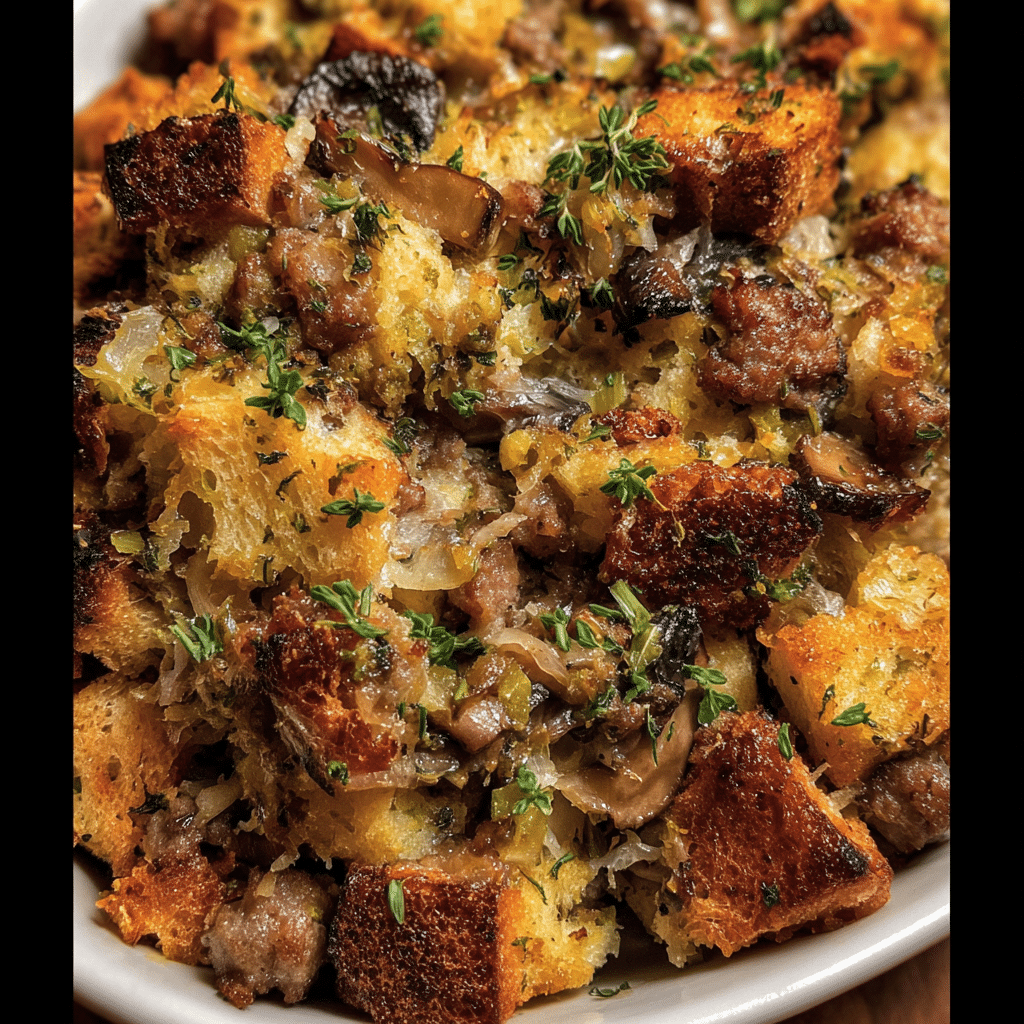
Troubleshooting Guide
Even the best cooks encounter problems, and it’s essential to troubleshoot common issues that might arise when preparing your best-ever sourdough stuffing. One frequent problem is that the stuffing turns out too dry. If you find this happening, don’t hesitate to add more broth gradually until the mixture is adequately moist. Remember, you can always add liquid, but you can’t take it away!
Another common issue is uneven cooking, especially if you’re stuffing a turkey with your sourdough stuffing. To avoid this, consider cooking your stuffing separately in a baking dish. This allows for even heat distribution and ensures your stuffing achieves that perfect golden-brown crust on top. Additionally, if you’re using a slow cooker, be mindful of the cooking time; it may take longer than traditional oven baking.
As for flavor, if your stuffing lacks that punch, consider adjusting your seasoning. A dash of salt or additional herbs can make all the difference. Always taste your mixture before baking to ensure it meets your flavor expectations.
Presentation Tips
Presentation is key when serving your best-ever sourdough stuffing, especially during festive gatherings. For a beautiful display, consider serving your stuffing in a rustic cast-iron skillet or a decorative baking dish. Garnish with fresh herbs like parsley or thyme to add a pop of color. You can also sprinkle some toasted nuts or crispy fried onions on top just before serving for an added crunch and visual appeal.
When it comes to wine and beverage pairings, think about the flavors in your stuffing. A crisp, dry white wine, such as Sauvignon Blanc or a light-bodied red like Pinot Noir, pairs beautifully with the savory elements of the dish. If you’re looking for non-alcoholic options, a sparkling apple cider can provide a refreshing contrast to the rich flavors.
Don’t forget about meal prep strategies! You can prepare your stuffing a day in advance by assembling the mixture and storing it in the refrigerator. Just add a bit more broth and let it come to room temperature before baking. This not only saves time but also allows the flavors to meld beautifully.
Lastly, if you’re planning to scale your recipe up or down, remember that the cooking time may vary accordingly. For larger batches, consider using a larger baking dish or multiple pans to ensure even cooking. The best-ever sourdough stuffing can be adapted to fit any gathering, making it a versatile choice for your holiday table or family dinners.
Creative Variations and Adaptations of best-ever sourdough stuffing
The beauty of the best-ever sourdough stuffing lies in its versatility. While the classic recipe is delicious, there are countless creative variations and adaptations you can explore to make this dish your own. Whether you’re looking to accommodate dietary preferences or simply want to experiment with seasonal ingredients, there’s a world of possibilities waiting for you!
Seasonal Variations
One of my favorite things about sourdough stuffing is how it can be adapted to the seasons. In the fall, consider adding roasted butternut squash or pumpkin for a sweet, earthy flavor. The addition of dried cranberries or apples can also provide a touch of sweetness that complements the savory ingredients beautifully. During the spring, why not incorporate fresh asparagus or peas for a vibrant burst of color and taste?
In the summer, you can blend in fresh herbs like basil, dill, or mint, along with roasted tomatoes for a Mediterranean flair. And during the winter months, try adding chopped chestnuts or walnuts for a nutty crunch. Each season brings unique flavors that can elevate your best-ever sourdough stuffing to new heights!
Dietary Adaptations
For those with dietary restrictions, the best-ever sourdough stuffing can easily be modified. If you’re aiming for a gluten-free version, look for gluten-free sourdough bread or use a blend of gluten-free breads. Just be sure to check the ingredients to avoid any hidden gluten sources.
If you need a vegan option, swap out the butter for olive oil or coconut oil, and replace any chicken broth with vegetable broth. You can also add plant-based sausages or mushrooms to provide that hearty texture and flavor you’d expect from traditional stuffing. For a keto-friendly variation, use low-carb bread alternatives and focus on incorporating plenty of vegetables and healthy fats.
Creative Twists
For those who love to experiment, there are endless creative twists to consider. How about a Mexican-inspired sourdough stuffing with chorizo, black beans, and corn? You could even dress up your stuffing with a bit of chipotle for a smoky kick. Another fun option is to create an Italian version by adding Italian sausage, sun-dried tomatoes, and plenty of herbs like oregano and basil.
Want to try something exotic? Think about a Moroccan-inspired stuffing featuring spices like cumin and coriander, along with dried fruits such as apricots and almonds. The best-ever sourdough stuffing can become a canvas for your culinary creativity, inviting you to explore flavors from around the world.
As for cooking methods, while baking the stuffing in the oven is traditional, you can also try preparing it in a slow cooker for a hands-off approach. This method allows the flavors to meld beautifully over a longer time, resulting in a deeply flavored dish. Alternatively, consider stuffing bell peppers or hollowed-out squashes with your sourdough stuffing mixture for individual servings that are both charming and delicious.
Lastly, don’t forget about transforming your leftovers! Use any remaining stuffing to make stuffed mushrooms or as a topping for a savory shepherd’s pie. You can even mix it into scrambled eggs for a hearty breakfast the following day. The best-ever sourdough stuffing truly shines in its adaptability, making it a dish that brings joy long after the holiday meal is over.
Storage, Reheating, and Meal Prep for best-ever sourdough stuffing
Storage, Reheating, and Meal Prep for best-ever sourdough stuffing
When it comes to preparing the best-ever sourdough stuffing, one of the most important considerations is how to store, reheat, and even meal prep this delicious dish. Whether you’re making it ahead of time for a holiday gathering or just want to savor it over several days, understanding the proper storage techniques can enhance your culinary experience.
Short-term Storage
After you’ve crafted your best-ever sourdough stuffing, the first step is to consider how to store it if you’re not serving it immediately. If you plan to eat the stuffing within a few days, your best option is to refrigerate it. Allow the stuffing to cool to room temperature before transferring it to an airtight container. This step is crucial because placing hot food directly into a container can create condensation, leading to sogginess and potential spoilage.
For best results, use a container that allows minimal air exposure. Glass containers with tight-fitting lids work wonderfully, but BPA-free plastic containers are also a good choice. When stored properly, your sourdough stuffing can last up to four days in the refrigerator. Remember to label the container with the date it was made, as this will help you track its freshness.
Freezing and Long-term Storage
If you want to extend the life of your best-ever sourdough stuffing even further, freezing is the way to go. This method is ideal for large batches or for those who want to prepare meals in advance. For freezing, you can portion the stuffing into smaller servings, making it easier to reheat later without defrosting the entire batch.
Use freezer-safe containers or resealable plastic bags for this purpose. If using bags, squeeze out as much air as possible before sealing. Label each bag or container with the date and contents. Properly stored, your stuffing can last up to three months in the freezer without compromising flavor or texture.
When you’re ready to enjoy your frozen best-ever sourdough stuffing, transfer it to the refrigerator to thaw overnight. This gradual thawing helps maintain its quality. If you’re short on time, you can also reheat it from frozen, but be sure to adjust your cooking time accordingly.
Reheating Best Practices
Reheating your best-ever sourdough stuffing properly is essential to preserve its flavor and texture. There are several methods to consider, depending on how much time you have and the texture you desire.
The oven is one of the best methods for reheating stuffing. Preheat your oven to 350°F (175°C). Spread the stuffing in an even layer in a baking dish, then cover it with foil to prevent it from drying out. Heat for about 20-30 minutes, or until it’s heated through. If you want to achieve a crispy top, remove the foil for the last few minutes of baking.
If you’re in a hurry, you can use the microwave. Place a serving of stuffing in a microwave-safe dish, add a splash of chicken broth or water to keep it moist, and cover it with a damp paper towel. Heat in intervals of 1-2 minutes, stirring in between, until hot.
For those who enjoy a stovetop method, simply heat a skillet over medium heat. Add a little butter or oil, then add the stuffing. Stir occasionally until warmed through. This method can add a nice crispiness to the edges.
Meal Prep and Batch Cooking Strategies
Meal prepping your best-ever sourdough stuffing is not only a time-saver but also a way to ensure you have delicious meals ready to go. Consider making a large batch on a weekend and portioning it into containers for the week ahead. This approach allows you to enjoy the flavors of your stuffing multiple times without the hassle of preparing it from scratch each time.
Another strategy is to assemble your stuffing but not bake it right away. You can prepare the mixture, store it in the refrigerator for a day or two, and bake it fresh right before serving. This method ensures ultimate freshness and flavor.
Food Safety Considerations and Guidelines
When storing and reheating your best-ever sourdough stuffing, food safety should always be a priority. Make sure to cool the stuffing down quickly after cooking to minimize the time it spends in the “danger zone” (between 40°F and 140°F), where bacteria can thrive. Additionally, ensure that your refrigerator is set to 40°F (4°C) or below, and your freezer is at 0°F (-18°C).
Always check for signs of spoilage before consuming leftovers. If the stuffing has an off smell, unusual color, or mold, it’s best to err on the side of caution and discard it. With proper handling and storage, you can enjoy your best-ever sourdough stuffing safely and deliciously.
Portioning and Packaging Tips
Portioning your best-ever sourdough stuffing for storage not only helps with meal prep but also allows you to control serving sizes. Using a measuring cup, divide the stuffing into single servings before packaging. This method is especially helpful for those who want to watch their portion sizes or for families with varying appetites.
When packaging, consider using vacuum-sealed bags for the freezer. This method removes air, helping to prevent freezer burn and preserving the stuffing’s quality. If you’re using containers, opt for ones that are stackable to save space in your fridge or freezer.
By following these storage, reheating, and meal prep strategies, you can ensure that your best-ever sourdough stuffing remains delicious and safe to eat, making it a delightful addition to your meals any time of the year.
Nutritional Benefits and Health Information
Nutritional Benefits and Health Information
When it comes to enjoying the best-ever sourdough stuffing, it’s not just about the flavor; it’s also about the nutrition it brings to the table. This dish, often enjoyed during festive occasions, can pack a punch of flavor while also offering several health benefits, depending on its ingredients.
Nutritional Profile
The nutritional profile of your best-ever sourdough stuffing largely depends on the specific ingredients you choose. On average, a serving of stuffing may contain around 200-300 calories, which can vary based on the amount of sausage, butter, and other ingredients used. The base of sourdough bread contributes carbohydrates, while the mushrooms and vegetables provide essential vitamins and minerals.
A typical serving might contain:
- Calories: 250
- Carbohydrates: 30g
- Protein: 10g
- Fat: 12g
- Fiber: 3g
Adding sausage can increase the protein content significantly, making the stuffing a more substantial dish. For those watching their dietary intake, keeping an eye on the sodium content from broth and sausage is also essential.
Health Benefits
One of the best aspects of the best-ever sourdough stuffing is the variety of ingredients that can enhance its health benefits. Sourdough bread is known for its lower glycemic index compared to regular bread, making it a more favorable choice for maintaining stable blood sugar levels. The fermentation process involved in making sourdough enhances its digestibility and nutrient absorption.
Mushrooms, a common addition to stuffing, are low in calories but high in antioxidants, vitamins (like B vitamins), and minerals, including selenium and potassium. These nutrients can help boost your immune system and support overall health.
Furthermore, herbs and vegetables added to the stuffing not only elevate the flavor but also contribute essential vitamins and minerals. For instance, celery provides vitamin K and folate, while onions add quercetin, a powerful antioxidant.
Dietary Considerations
When preparing your best-ever sourdough stuffing, it’s important to consider dietary restrictions and allergen information. Traditional stuffing recipes may not be suitable for gluten-free diets, but gluten-free sourdough options are becoming more available. Always check labels to ensure the bread complies with gluten-free standards if needed.
For those following a vegetarian or vegan diet, substituting sausage with plant-based alternatives or omitting it altogether can make this dish suitable. You can enhance the flavor with a variety of spices and additional vegetables to maintain depth in taste.
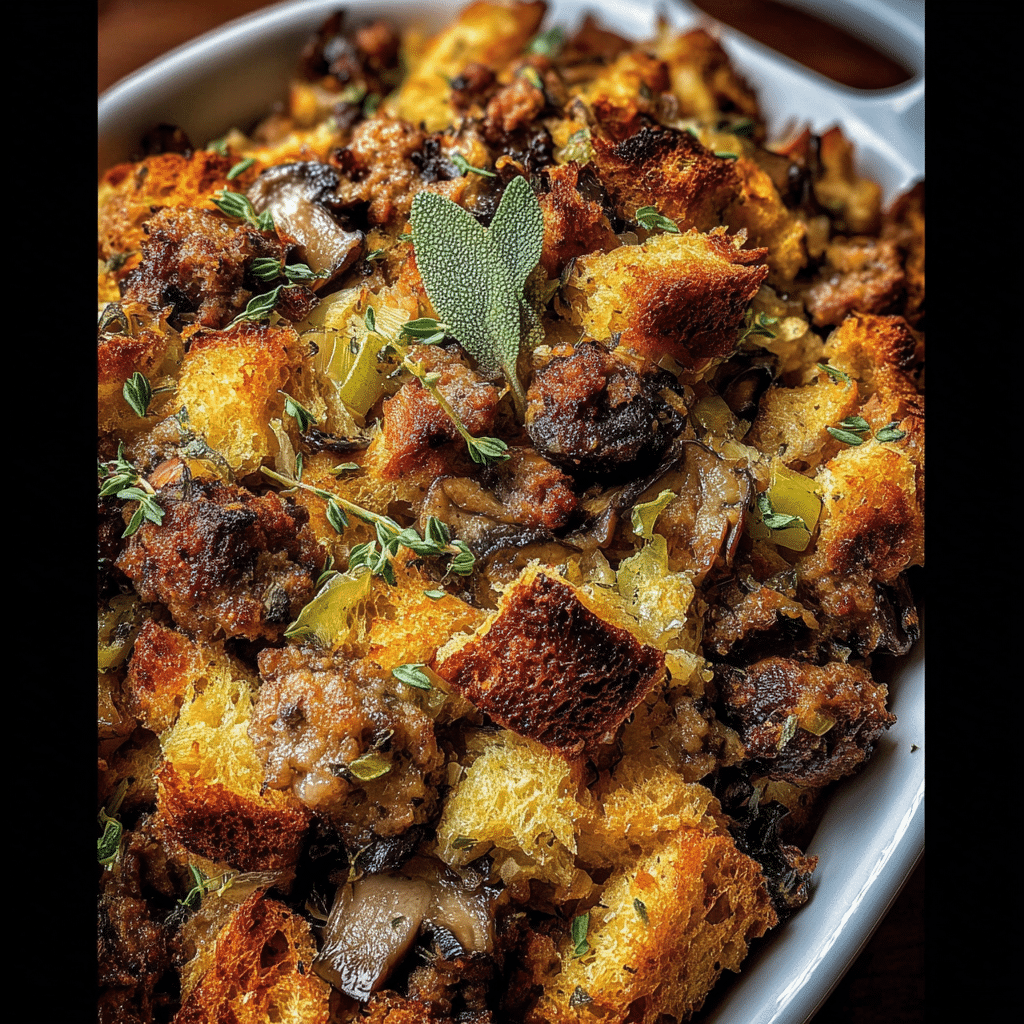
For individuals with food allergies, particularly to nuts or dairy, it’s essential to read ingredient labels carefully. Many store-bought broths contain allergens, and homemade versions can be tailored to fit your dietary needs.
Healthy Modification Suggestions
While the best-ever sourdough stuffing is delicious in its classic form, there are plenty of ways to modify the recipe to make it even healthier. Consider swapping out butter for olive oil or avocado oil to reduce saturated fat. Additionally, using low-sodium broth can help decrease the overall sodium content without sacrificing flavor.
Incorporating more vegetables is another great way to enhance the nutritional profile. Spinach, kale, or bell peppers can add color, flavor, and nutrients. You might also experiment with whole grains by blending some whole grain bread into the sourdough mix, adding fiber and nutrients.
Comparison with Similar Dishes
When compared to other stuffing varieties, the best-ever sourdough stuffing stands out for its unique flavor and texture due to the sourdough bread base. Traditional bread stuffing may be denser and higher in calories, especially if made with enriched white bread. Sourdough’s fermentation process not only enhances flavor but also makes it easier to digest, which can be beneficial for those with sensitive stomachs.
Moreover, many commercial stuffing mixes may contain preservatives and additives, which can detract from the overall healthiness of the dish. Making your stuffing from scratch allows you to control the ingredients, ensuring a wholesome and delicious meal.
In conclusion, the best-ever sourdough stuffing not only serves as a comforting and flavorful addition to any meal but also offers numerous health benefits thanks to its wholesome ingredients. By being mindful of your dietary needs and making thoughtful ingredient choices, you can enjoy this dish guilt-free, savoring the memories and flavors that come with each bite.
Frequently Asked Questions About Best-Ever Sourdough Stuffing
Sourdough stuffing with sausage and apples
For a delicious sourdough stuffing with sausage and apples, start by browning your favorite sausage in a skillet to render its fat and build flavor. Use a mix of tart apples, like Granny Smith, to balance the richness of the sausage; chop them into bite-sized pieces. Combine the sautéed sausage and apples with cubed sourdough bread, sautéed onions, and celery, and moisten with a mixture of chicken broth and herbs such as sage and thyme. Make sure to let the stuffing sit for at least 30 minutes before baking, allowing the bread to absorb the flavors. Bake it until golden brown on top for a delightful texture contrast.
Sourdough sausage mushroom stuffing
To create a robust sourdough sausage mushroom stuffing, start by sautéing diced onions, garlic, and a mix of earthy mushrooms like cremini and shiitake in butter or olive oil until golden. Brown your choice of sausage separately and then combine it with the mushrooms, adding fresh herbs like parsley or thyme for added depth. Toss this mixture with cubes of sourdough bread and enough broth to ensure the bread is well-moistened but not soggy. Allow the stuffing to rest before baking to enhance the flavors, and bake until the top is crispy and the inside is flavorful and moist.
Sausage and sourdough stuffing wishbone kitchen
For a flavorful sausage and sourdough stuffing inspired by Wishbone Kitchen, begin by selecting high-quality sausage and browning it in a large skillet with onions and celery until they are tender. Incorporate fresh herbs, such as sage and rosemary, to elevate the dish’s complexity. Mix this savory blend with cubes of crusty sourdough bread and enough broth to achieve your desired texture. Consider adding toasted nuts or dried fruits for an unexpected crunch and sweetness. Bake until the top is crispy and golden, ensuring a delightful contrast to the soft, aromatic stuffing beneath.
Sausage mushroom chestnut stuffing
For a heartwarming sausage mushroom chestnut stuffing, start by roasting fresh chestnuts until they’re tender and easy to peel. Sauté onions, garlic, and mushrooms in butter, then add the crumbled sausage, allowing it to brown and infuse the stuffing with flavor. Combine this mixture with sourdough bread cubes and chopped chestnuts, and moisten with broth and a splash of sherry or white wine for added depth. If you enjoy a bit of sweetness, consider adding dried cranberries or figs. Bake until the stuffing is golden and the flavors have melded beautifully.
Boudin sourdough stuffing recipe with sausage
To create a unique boudin sourdough stuffing, begin by sourcing authentic boudin sausage, which adds a distinct flavor profile to your dish. Sauté onions, bell peppers, and celery until soft, then mix in the boudin, breaking it apart as you cook. Combine this mixture with cubed sourdough bread and add chicken broth to moisten it properly. For extra flavor, consider incorporating Cajun seasoning or fresh herbs like thyme. Bake it until the top is crispy, allowing the flavors to develop and meld deliciously.
Italian sausage mushroom stuffing
For an Italian twist on stuffing, use spicy or sweet Italian sausage and sauté it with garlic, onions, and an assortment of mushrooms until everything is beautifully browned. Add chopped fresh herbs, such as basil and oregano, to give it that classic Italian flavor. Mix this savory blend with cubed sourdough bread and plenty of chicken or vegetable broth to ensure it’s moist. Consider adding grated Parmesan or provolone cheese for a creamy texture and rich flavor. Bake until the top is golden and crispy, providing a delightful contrast to the moist stuffing underneath.
Sausage and wild mushroom stuffing
To craft a savory sausage and wild mushroom stuffing, start by using a variety of wild mushrooms like chanterelles or morels for an earthy flavor. Sauté these mushrooms with onions and sausage until browned, allowing the fat to impart richness to the stuffing. Combine this mixture with cubed sourdough bread and moisten it with broth infused with herbs such as thyme and tarragon. If you want to elevate the dish further, adding a splash of sherry or white wine will deepen the flavor. Bake until the top is crisp and the flavors are harmoniously blended.
Sourdough mushroom stuffing recipe
For a delightful sourdough mushroom stuffing recipe, begin by sautéing your choice of mushrooms along with onions and garlic until they are soft and fragrant. To enhance the flavor, consider adding herbs like thyme and parsley. Mix the sautéed vegetables with cubed sourdough bread and moisten with vegetable or chicken broth, ensuring the mixture is well-combined but not overly soggy. For added texture, you can incorporate toasted walnuts or pecans. Bake until the top is golden brown and the stuffing is hot throughout, allowing all the flavors to meld beautifully.
Conclusion: Mastering the Perfect best-ever sourdough stuffing
Creating the perfect best-ever sourdough stuffing is more than just following a recipe—it’s about understanding the techniques, ingredients, and cultural significance behind this beloved dish. Throughout this comprehensive guide, we’ve explored everything from the historical origins to modern variations, ensuring you have all the knowledge needed to make this recipe your own.
Whether you’re a beginner cook or an experienced chef, the techniques and tips we’ve shared will help you create a best-ever sourdough stuffing that’s not only delicious but also meaningful. Remember that cooking is a journey of discovery, and each time you make this dish, you’ll learn something new.
We encourage you to experiment with the variations we’ve discussed, adapt the recipe to your dietary needs, and most importantly, share it with the people you love. Food has the incredible power to bring people together, and Best-Ever Sourdough Stuffing with Sausage & Mushrooms is the perfect dish to create lasting memories around your dinner table.


